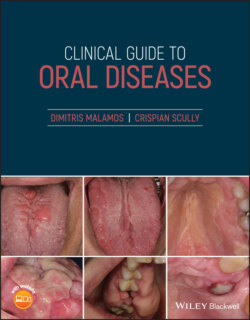Читать книгу Clinical Guide to Oral Diseases - Crispian Scully - Страница 40
Case 3.4
ОглавлениеFigure 3.4
CO: A 23‐year‐old woman is referred by her physician to be evaluated for the brown patchy discoloration of her lips.
HPC: The lesions were first noticed by her mother at the age of 10, increasing in number and intensity during puberty and fading over the last three years.
MH: She suffered only from an iron deficiency anemia and bowel problems (constipation) which were initially attributed to the use of iron supplement tablets during the days of her heavy menstrual cycle, but recently, to the two small benign polyps in her small intestine. It has to be underlined that her father had a history of a colorectal carcinoma. Recent blood tests (hematological/biochemical) were within a normal range, as was her blood pressure. She was an occasional smoker and drinker, as she enjoyed mountain climbing in her free time.
OE: A thin, woman with brown lesions on the vermillion borders of her lips (lower lip mainly) (Figure 3.4), lower gingivae and buccal mucosae and on the skin around her right eye. The lesions were flat, superficial, brown discolorations with no evidence of induration or bleeding on palpation, and not associated with local lymphadenopathy or other mucosal lesions.
Q1 What is the possible cause?
1 Solar melanosis
2 Hemosiderosis
3 Cushing syndrome
4 Peutz‐Jeghers syndrome
5 Laugier‐Hunziker syndrome
Answers:
1 No
2 No
3 No
4 Peutz‐Jeghers syndrome (PJS) is the cause and characterized by numerous brown pigmented lesions on the skin, mouth, and other mucosae together with hamartomatous polyps in the gastrointestinal tract. It is an autosomal dominant genetic disease with an increased risk of developing cancer in a number of organs as found in her father with similar oral pigmentation.
5 No
Comments: The pigmented skin lesions could be attributed to chronic skin exposure to solar radiation during her mountain climbing, but the presence of intra‐oral lesions together with the presence of polyps exclude solar melanosis and Laugier‐Hunziker syndrome from the diagnosis. The abnormal laboratory tests and characteristic clinical features found in Cushing syndrome and hemosiderosis includes these conditions in the diagnosis.
Q2 Which is the major complication of Peutz‐Jeghers syndrome?
1 Melanoma
2 Blindness
3 Carcinoma
4 Bowel obstruction
5 Osteoporosis
Answers:
1 No
2 No
3 Increased risk of gastrointestinal carcinomas and other extra‐intestinal malignancies occur in patients with Peutz‐Jeghers syndrome even at an early age.
4 No
5 No
Comments: The pigmented oral and skin lesions in PJS are characterized by increased melanin production, which derives from an increased number of normal melanocytes, which do not show architectural or cytologic atypia or the great number of mitoses as seen in melanoma. In patients with PJS, bowel obstruction is common and arises from the polyps, while osteoporosis induced from pituitary adenomas is rare, yet neither of them jeopardize patient's life. Blindness is not characteristic clinical finding of PJS.
Q3 Which of the laboratory tests below may be done in patients with PJS on a regular basis?
1 Endoscopy/colonoscopy
2 U/S of the abdomen
3 Stool analysis
4 Mammography
5 Blood tests for anemia
Answers:
1 Endoscopy and colonoscopy are useful investigations for detecting intestinal polyps.
2 No
3 Stool analysis and particularly fecal occult blood tests can be used to diagnose gastrointestinal bleeding from an ulcerated polyp or colorectal or stomach cancer, while other tests such as colonoscopy, double control barium enema or stool DNA tests, seem to be more useful.
4 No
5 Anemia, especially due to iron deficiency, is a common finding among PJS patients due to chronic intestinal bleeding from polyps.
Comments: Mammography is an irrelevant test and used for detection of breast anomalies, especially in women, while the abdominal U/S is useful for anomalies of the structures of the upper abdomen in both sexes.
